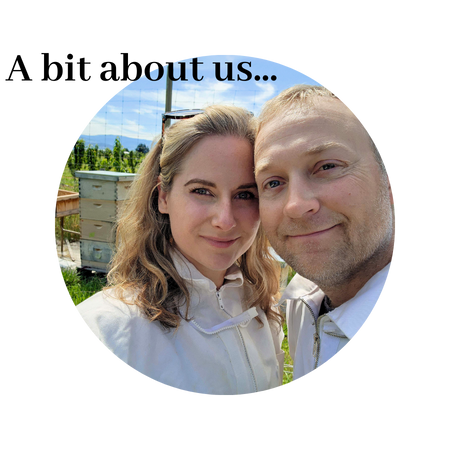When starting beekeeping, one of the very first things you should do is get to know your bees. Learning about the bees before even getting them is key.
So let's talk about the life cycle of a honey bee.

Honey Bee Development
Honey Bees undergo a miracle that is called "complete metamorphosis". It is essentially the honey bee life cycle.
The honey bee life cycle means they go from egg to larva to pupa to adult. The timing is different for each caste or type of bee in the hive, but in total, honey bee development time is different for each caste:
- A Queen bee takes 16 days to go from egg to adult
- A worker bee takes 21 days to go from egg to adult
- A drone bee takes 24 days to go from egg to adult
Egg laying
The Queen bee in a colony of honey bees (who can lay thousands of fertilized eggs per day) lays an egg in the bottom of the honey comb wax cell. The egg is glued down by the small end and looks like a small grain of rice in a curved C shape.
If you, as a beekeeper, can see eggs in the bottom of your wax cells, it tells you a lot about the beehive.
When you see eggs in the bottom of the cells in a beehive, here is what that means:
When you see eggs in the bottom of your honey bees cells, that means that the Queen is alive and well, and was laying eggs at least three days ago. It also gives you some idea of how prolific the current Queen is in her egg-laying.
If you see frame after frame of eggs, then you have a good indication that she is a good laying Queen with a good searching behavior. This is a valuable trait in a Queen.
The Queen bee decides what the eggs will become.
There is a small opening at the top of the egg (called a microphile) which is used by the Queen to fertilize the egg. An egg that is fertilized will become a worker bee (a haploid egg) and an egg that is not fertilized will become a drone (a diploid egg). The Queen decides what the egg will become.
We say an egg hatches, but in reality, the shell of the honey bee egg simply dissolves. A Queen bees eggs will develop in 2-4 days depending on the weather.
When bee eggs do "hatch", they become honey bee larvae.
Honey Bee Larva
For honey bees, the larva stages last about 4-6 days. A honey bees larva is really just a feeding machine and is basically a small digestive system. They soak in their food like a bath through absorption.
The food that is made for the honey bees larva is secreted by the worker bees and comes in the form of a jelly.
The larva feed heavily on this jelly and they grow extremely fast. If you look at a hive frame and you see larvae that are swimming in jelly, you know that they are not starving and in fact, they are well-fed. This is a very good indication of your bee hive health.
Larva which are not fed as much do not grow into their full size as worker bees. As bee larvae feed, they age and grow and eventually completely fill the cell.
This is significant growth. If humans grew at the same rate we would be the size of an elephant in five days after being born.
Honey Bee Larvae Health
When you look at your honey bee larvae and they are glistening white, that is a great sign they are healthy. If the bee larvae look coffee-coloured or yellow-colored, then the hive may have a disease.
In the larva stage, honey bee larvae grow by shedding their skin. A honey bee larvae will shed their skin around 6 times, and these are called molts. Their weight grows by 900 times and they will receive around 1300 visits per day by worker bees. Wow, that's some high maintenance babies!
The larva stage of the honey bee is completely focused on feeding and growing.
Honey Bee Pre-Pupa
As the honey bee larva grows, it lengthens itself out so it is straight and no longer in the C shape. This is a resting stage and it lasts only a day. During this phase, the larva changes from honey bee larva, to honey bee pupa.
At this point, the honey bee has lost most of its musculature and is basically composed of genetic material and is no longer feeding.
Here is a frame of ours, not a great frame as there are both honey cell and brood here and you don't want that; but it shows the cells in the middle that are darker for baby bees and on the bottom corner, that is honey.
Honey Bee Pupa
The worker bees of the hive make a cap on the the cell holding the pre-pupa with wax to seal them in for their final stage. The pupa will stay under the wax cap for over 12 days if it is going to become a worker during which time, the pupa undergoes a metamorphosis.
A worker bee takes 12 days in this stage, but a Queen in this stage only takes 7 days. This stage of honey bee development is complete when the honey bee emerges as an adult.
Here is a photo of a frame of brood from one of our backyard hives. These are all baby bees about to come out! They are being tended to by the worker nurse bees.

Honey Bee Adult
After emerging from the wax-capped cell, the adult bee, whether it's caste is a Queen, a worker or drone, begins its life, focused on the tasks associated with that caste.
For example, the workers will get right to work. The next step in the life of the honey bee is fascinating and their decisions (if you can call them that) are focused on what is best for their honey bee colony. Their stories are full of danger, brutal realities and mostly constant work, both day and night.
Here's another one from our hives with the Queen bee in the middle!
Each adult bees caste/classification has an extremely important role in the honey bee hive, and these castes are required to keep the hive going.
Of course, this is a basic overview on honey bee development. You could read on and on if interested in learning more about Queen bees and fertilized eggs (and even unfertilized eggs and virgin Queens and the mating flight as well). There is also so much to be said about Queen honey bees and how they develop through being fed royal jelly. We could write an entire article on what happens when a larvae is fed royal jelly, and exactly what royal jelly is. Another time though.
We hope you enjoyed the article!
Here are some other articles you may be interested in reading:
Everything Needed To Start BEEKEEPING
Where To Buy Beeswax Directly From Reputable Beekeepers
How To Make Beeswax Wraps | INSTRUCTIONS
Did you like this article?
❤️ Here's how you can support our blog:
My name is Linnea and I am a backyard gardening enthusiast! Along with my husband and our two kids (and chickens, ducks and our little dog Izzy). Our hobby - growing our own food and making our meals from scratch. My blog, The Farmers Cupboard, is the website that blossomed from that passion. I love every second I spend sharing our hobby with like minded backyard growers.
It's easy to support my blog, and it is so appreciated. Please SHARE an article somewhere, pin a photo to your Pinterest board, follow on any of our social medias or sign up for our newsletter! That's it!
These little things help our blog grow and allow us to continue doing what we love: growing good food and sharing what we learn.
PINTEREST PASSIONATE? We're opening up our cupboard to you!
Click on the pin below made just for you. It will bring you right to my little Pinterest community, where I would love for you to FOLLOW The Farmers Cupboard and see all of our gardening and backyard dream ideas!
Let's grow good things together!












0 comments